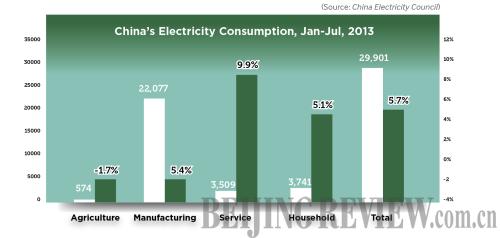|
 |
|
POWER SUPPLY: Transmission line towers from the left bank power station of the Three Gorges Dam (ZHENG JIAYU) |
Walking under the scorching Beijing sun, Li Yuxuan said she felt the heat of the road had penetrated the soles of her shoes. "Pour some cumin on me, and I will become a slice of barbecue meatloaf," she joked.
In fact, plenty of records regarding the weather have been set this summer. On July 30, the China Meteorological Administration launched a level two emergency response (the second most serious of four levels of emergency response) regarding the heat for the first time. In Chongqing, one of China's "Four Furnaces," some primary schools arranged all courses in the morning and sent students home before the heat struck.
Nonetheless, unlike in the past, power shortages seem to have been wiped from the list of complaints this year. In 2011, electricity shortages swept across most Chinese provinces and cities. Coal shortages led to power rationing and blackouts, and the demand gap once hit 3,000 GW. More power rationing was called for in 2012. But this summer, there was none, despite the sweltering heat.
Though high temperatures tortured two thirds of Chinese provinces and cities this summer, power companies said strictly controlling electricity use was not necessary. While that's good news for those who make full-blast use of their air conditioners, the need not to ration power is indicative of a wider trend: a slower growing Chinese economy.
A slowing real economy
"Around this time in previous years, the company would have received at least two power rationing notices. But this year, none have been issued," said Li Tao, President of Kaifeng Pengyuan Glass Fiber Products Co. Ltd.
In the first half of the year, electricity consumption in the manufacturing industry increased 4.9 percent year on year, 0.4 percent slower than total electricity consumption in the country. Li Huiyong, Chief Economist at Shenyin & Wanguo Securities, believed that since the manufacturing industry made up 73.8 percent of total electricity consumption, it was behind the slowdown of consumption over all.
A report released by China International Capital Corp. Ltd. in July made a comparison between electricity consumption and GDP growth. From 2005 to 2007, China's GDP grew at a pace of more than 11 percent, while total electricity consumption rose rough 13 percent. From 2008 to 2009, affected by the global financial crisis, GDP growth slowed down to 9 percent, and total electricity consumption rose by 5 to 7 percent.
"When the economy expands rapidly, electricity consumption is high," said Lin Boqiang, Director of China Center for Energy Economics Research at Xiamen University. "Then if supply and demand are in a balanced state, an electricity shortage is inevitable during the summer because more power is needed to combat the heat."
Lin predicted less power would be used in China this summer because power consumed by a variety of industries was lowering. Since the manufacturing industry contributes more than 70 percent to total power consumption, surging power consumption by households and the services industry cannot offset the slide.
His viewpoint was echoed by Li Huiyong, who argued the gloomy real economy left a surplus in power supply, so even though people consumed more power to beat the summer heat, power supply would not fall behind demand.
In the first half of the year, depressed by rising costs, overcapacity and shrinking exports, China's manufacturing industry was on the rocks. Small and micro businesses were pushed to the brink of bankruptcy. Zhuang Jian, Senior Economist of Asian Development Bank, argued a capital transfer to the real estate, securities and financial industries was a major cause behind slow growth in manufacturing. China has big designs for the services industry to become a new engine of growth in the country.
In late 2010, The Economist unveiled a new index to measure China's GDP growth. Named after Chinese Premier Li Keqiang, the index is composed of three economic indicators: power consumption, railway freight and bank loans, which Li himself once said were better indicators of GDP growth.
A space to breathe
Given the current reduced pressure on national power supplies, experts say it is time for the power industry to become more efficient. Furthermore, new energy—such as solar power and nuclear power—should have a bigger role to play in China's energy needs in the near future.
The National Energy Administration recently released interim provisions for distributed generation—generating electricity from many small energy sources, encouraging enterprises, energy service companies and individuals to invest in distributed generation projects, which will give a leg up to alternative power sources.
Although overall electricity consumption was down, it did little to prevent a nasty brew of brown smog from blanketing Beijing during the summer. Most days in July and August, the air was "moderately polluted" or "heavily polluted" according to various air quality indices. Much of the pollution came from coal-fire power plants. According to the Northwest Regulatory Bureau of State Electricity Regulatory Commission as early as 2008, there were 103 self-generation power plants in north China, taking up 10 percent of total electricity production capacity.
Given that China's electricity consumption is drastically falling due to a slowdown in the manufacturing industry, the time is ripe to develop more alternative sources of energy and lessen the use of coal.
Email us at: dengyaqing@bjreview.com

| 